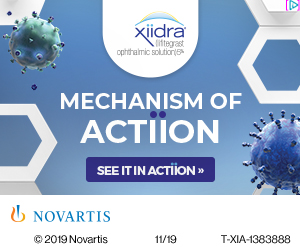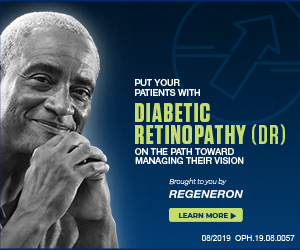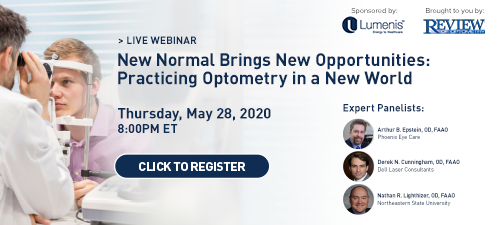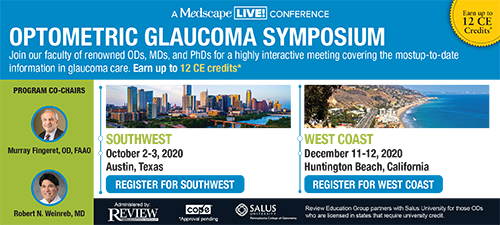
A
weekly e-journal by Art Epstein, OD, FAAO
Off the Cuff: Our CE Conundrum
There is not much good you can say about a pandemic where uncertainty has become the norm, other than it forces you to think about things you normally wouldn’t think about. I suspect that 2020 will be a year we think about as much for its opportunity as its overwhelming tragedy. Life out of round during this outbreak had a disconnected and surreal quality. It has also been a pressure test for much of what we blindly accepted as normal and necessary. Maybe it’s time to look at things differently. Continuing education and maintenance of competence have always been essential requirements for health care providers. With constant advances in knowledge and rapid developments in technology and pharmacology, continuing education is more important now than it has ever been. Yet, continuing education for health care professionals, optometry included, is essentially the same as it was in the 1960s, well before the computers and internet age started. The COVID outbreak confirmed that this approach no longer makes any sense. Certainly not as the only approach. With the outbreak making it impossible for doctors to attend meetings, students to attend classes, and large meetings shuttered indefinitely, relaxation of what are antiquated CE rules almost instantly exposed virtually all of us to distance learning. Based on what I’ve observed and experienced, online education has been a smashing success. Effective and more convenient, especially as our lives become busier and our time becomes more precious, distance learning is clearly the way of the future. I venture that few of you have not sat in on a Zoom or Webex webinar over the past few weeks. Did you learn something new and useful? I bet you did. Continuing education should not be a race for credits to satisfy a COPE or state board requirement, but rather an on ongoing quest for knowledge to become a better and more effective clinician. Given the state of technology, the effort should be easily scalable and validatable. It makes no sense that in a few short weeks we will be forced to return to less convenient and, in many ways less verifiable in-person education, abandoning what we’ve learned about how education can be effectively delivered and deployed during even the most challenging times.I don’t have all of the answers, but I think our educators, regulatory boards, and state and national organizations need to very quickly rethink the CE status quo. From many conversations I’ve had, our colleagues like online education and distance learning, and they are not going to happily go back to sitting in cramped, stuffy rooms at inconvenient times. I propose a meeting—virtual or in-person—of all education stakeholders to revise current CE delivery systems with something scalable for the growing information explosion and the need for more flexible educational formats. As someone who has spent the better part of a lifetime educating peers, I would be happy to assist in organizing it. Either way, it is something that will be coming and coming soon. I think that new normal that everyone is talking about likely won’t be that new; but it will hopefully be the old normal, just better.
|
|||||
 |
||
| The Efficacy of Intense Pulsed Light Combined with Meibomian Gland Expression for the Treatment of Dry Eye Disease Due to Meibomian Gland Dysfunction: a Multicenter, Randomized Controlled Trial | ||||
These researchers compared the efficacy of intense pulsed light (IPL) combined with meibomian gland expression (MGX) and instant warm compresses combined with MGX, for treatment of dry eye disease (DED) due to meibomian gland dysfunction (MGD). In a prospective, multicenter, interventional study, 120 subjects with DED due to MGD were randomized 1:1 to an IPL arm or a control arm. Each subject was treated three times at three-week intervals. The primary outcome measure was the tear break-up time (TBUT). Tear break-up time and a few additional outcome measures were evaluated at the baseline and at three weeks after the last treatment. All outcome measures improved in both arms, but in general, the improvement was significantly larger in the IPL arm. Tear break-up time increased by 2.3±1.9 and 0.5±1.4 sec, in the IPL and control arms respectively. SPEED was reduced by 38% and 22% in the IPL and control arms, respectively. Meibomian Gland Yielding Secretion Score was improved by 197% in the IPL arm and 96% in the control arm. Corneal fluorescein staining also decreased by 51% and 24% in the IPL and control arms, respectively, but the differences between the two arms were not statistically significant. A composite score of lid margin abnormalities improved in both arms, but more in the IPL arm. |
||||
SOURCE: Xiaoming Yan, Jing Hong, Xiuming Jin, et al. The Efficacy of intense pulsed light combined with meibomian gland expression for the treatment of dry eye disease due to meibomian gland dysfunction: a multicenter, randomized controlled trial. Eye Contact Lens. 2020 May 19. Online ahead of print. |
||||
 |
||
| A Systematic Review of Emerging Therapeutic Strategies in the Management of Chemical Injuries of the Ocular Surface | ||||
To evaluate recent in vivo studies on emerging therapies for managing corneal epithelial injuries, a search was conducted on PubMed for articles published between January 2015 and September 2019, and in the English language. Thirty studies were identified for evaluation, including those on mesenchymal stem cells, amniotic membrane-derived therapies, endogenous peptides and their inhibitors, as well as hydrogel therapies. Intermediate to strong levels of evidence was presented regarding the use of these strategies on chemically injured corneas. This included the effect on healing of corneal epithelial defects, anti-inflammatory properties, prevention of corneal neovascularization, as well as restoration of anatomy and functions of the anterior eye, although the researchers wrote that clinical trials would be needed to determine the safety and efficacy of these strategies on humans. The researchers concluded that recent advances and understanding in various novel therapeutic methods for corneal epithelial chemical injuries should provide potential alternatives to current standard treatment regimens and help reduce risks of complications, consequently improving patient outcomes. |
||||
SOURCE: Poon SHL, Wong WHL, Bu Y, et al. A systematic review of emerging therapeutic strategies in the management of chemical injuries of the ocular surface. Eye Contact Lens. 2020; May 22. [Epub ahead ahead of print]. |
||||
| Characteristics, Behaviors, and Awareness of Contact Lens Wearers Purchasing Lenses Over the Internet | ||||
To describe the characteristics and hygiene habits of contact lens (CL) wearers who acquire CLs over the internet, as well as their awareness of modifiable risk factors (RFs), a web-based survey was conducted among clients of an online CL sales platform during six months. Demographic data, CL hygiene-related awareness, and compliance were collected and analyzed. |
||||
SOURCE: Mingo-Botín D, Zamora J, Arnalich-Montiel F, et al. Characteristics, behaviors, and awareness of contact lens wearers purchasing lenses over the internet. Eye Contact Lens. 2020; May 14. [Epub ahead of print]. |
||||
 |
||
| News & Notes | ||||||||
| AAOF Announces William C. Ezell Fellowship Recipients The American Academy of Optometry Foundation announced the 11 recipients of the 2020 William C. Ezell Fellowships. The fellowship program is named after AAOF Founding President William C. Ezell, OD, and was established to recognize and support talented post-doctoral students who are pursuing an advanced degree in optometric research and education. View the recipients. |
||||||||
|
||||||||
| Kala Announces FDA Accepts NDA for Eysuvis Kala Pharmaceuticals announced the FDA accepted for review the company’s New Drug Application resubmission for Eysuvis (loteprednol etabonate ophthalmic suspension) 0.25%, its product candidate for the short-term treatment of the signs and symptoms of dry eye disease. The FDA stated that the NDA resubmission is a complete, class 2 response to the Complete Response Letter issued in August 2019, and the FDA set a Prescription Drug User Fee Act goal date of Oct. 30, for the completion of its review of the NDA. Read more.
|
||||||||
| Eaglet Eye Releases Eye Surface Profiler v5.0 Eaglet Eye announced release of Eye Surface Profiler (ESP) software version 5.0. The new image processing algorithms deliver up to 50% more of the scleral surface. In addition, Eaglet Eye has added several new features including improved First Lens Fit algorithms, and other data and capability improvements. The new software captures a larger and enhanced image of the sclera, in addition to DirectConnect, enabling one-touch ordering between the user and their preferred lab. Learn more. |
||||||||
| Virtual Clinical Training Program Educating Optometry Students In March, the American Academy of Optometry, in partnership with the Association of Schools and Colleges of Optometry, launched a virtual clinical education program to assist with case-based learning for optometry students. With cooperation from deans and faculty members of optometric schools and colleges, more than 2,300 students have attended sessions from more than 25 institutions across the US and Canada. Learn more. |
||||||||
| X-Cel Offers Scleral Patient Kit with Every Spare Pair Purchase X-Cel Specialty Contacts is adding a free Atlantis Scleral Patient Kit to its Bounce Back to Business program. The patient kit will be included free of charge with any Atlantis spare pair purchase. As part of the Bounce Back program, X-Cel has also removed the 90-day window from its spare pair program and will honor the spare pair pricing for any Atlantis lenses purchased within the last year. The spare pair program extension and free kit will run through Aug. 31. Learn more. |
||||||||
| New Telehealth Platform for ODs Goes Live July 1 A new telemedicine platform, Telasight, will provide real-time optometric practitioners with the ability to obtain consultations for rapid second opinions while the patient is in the office. The service will go live July 1. Designed to help optometrists reduce unnecessary referrals while building stronger doctor-patient relationships and increasing revenue from medical insurance billing, Telasight offers communication between providers, and enables easy sharing of clinical data and images such as visual fields and OCTs. Started by optometrists, the company has established a consultant network with leading experts such as Kyle Cheatham, OD; Greg Caldwell, OD; Paul Karpecki, OD; Richard Mangan; Lee Peplinski, OD; and Joseph Sowka, OD. Learn more. |
||||||||
| Eye Designs Group Acquires Fashion Optical Displays Eye Designs reached an agreement to acquire Fashion Optical Displays. With 40 plus years in the eye care industry, Fashion Optical Displays, which sustained tremendous fire damage to its headquarters and manufacturing facility in Paradise, Calif., in 2018, is known for its expertise in space planning, manufacturing and interior design services for eye care professionals. Learn more. |
||||||||
| New Alcon Program Helps ECPs Tap Into Opportunities in Dry Eye Market Alcon launched the “No Reason to Wait: Success Starts Now” program aimed at helping eye care professionals better understand the practice and patient benefits of treating the root cause of evaporative dry eye, meibomian gland dysfunction, which plays a large role in patients impacted by dry eye. As the eye care community recovers from the impact of the COVID-19 pandemic, this program is designed to help practitioners who don’t currently own a Systane iLux system identify new ways to service and retain existing patients, and implement strategies for supporting economic recovery of their practices. Learn more. |
||||||||
Kubota Electronic Eyeglasses to Stop Myopia in Children Show Positive Clinical Results Kubota Vision announced positive clinical results from myopia control tests in humans. Utilizing electronic tabletop optical projection devices that embody Kubota Glasses technology, researchers projected myopically defocused images on the peripheral retina of subjects to study if progression of myopia might be prevented by this method. Based on the positive findings, Kubota Vision will accelerate the program to develop wearable devices to prevent myopia in children. Read more. |
||||||||
|
Optometric Physician™ (OP) newsletter is owned and published by Dr. Arthur Epstein. It is distributed by the Review Group, a Division of Jobson Medical Information LLC (JMI), 19 Campus Boulevard, Newtown Square, PA 19073. HOW TO ADVERTISE |



